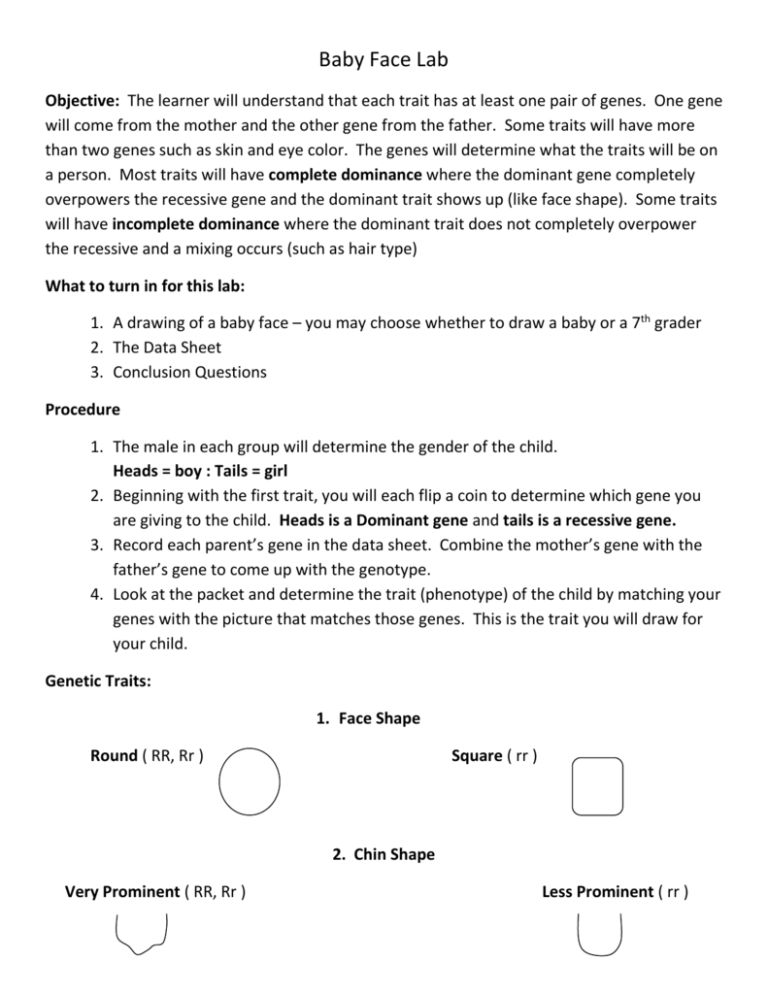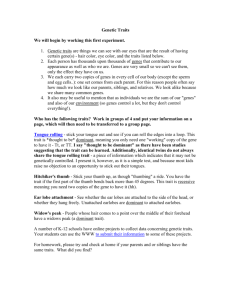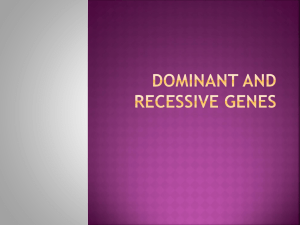Present
advertisement

Baby Face Lab Objective: The learner will understand that each trait has at least one pair of genes. One gene will come from the mother and the other gene from the father. Some traits will have more than two genes such as skin and eye color. The genes will determine what the traits will be on a person. Most traits will have complete dominance where the dominant gene completely overpowers the recessive gene and the dominant trait shows up (like face shape). Some traits will have incomplete dominance where the dominant trait does not completely overpower the recessive and a mixing occurs (such as hair type) What to turn in for this lab: 1. A drawing of a baby face – you may choose whether to draw a baby or a 7th grader 2. The Data Sheet 3. Conclusion Questions Procedure 1. The male in each group will determine the gender of the child. Heads = boy : Tails = girl 2. Beginning with the first trait, you will each flip a coin to determine which gene you are giving to the child. Heads is a Dominant gene and tails is a recessive gene. 3. Record each parent’s gene in the data sheet. Combine the mother’s gene with the father’s gene to come up with the genotype. 4. Look at the packet and determine the trait (phenotype) of the child by matching your genes with the picture that matches those genes. This is the trait you will draw for your child. Genetic Traits: 1. Face Shape Round ( RR, Rr ) Square ( rr ) 2. Chin Shape Very Prominent ( RR, Rr ) Less Prominent ( rr ) 3. Cleft Chin Present ( AA, Aa ) Not Present ( aa ) 4. Skin Color Skin color requires more than just two genes, it requires six. Each parent will flip the coin three times. Record an A for the first flip, a B for the second and a C for the third. Make sure heads is a capital letter and tails is lower case. Count the dominant (heads or capital letters) genes to figure out the skin color using the chart below. 6 dominant genes 5 dominant genes 4 dominant genes 3 dominant genes 2 dominant genes 1 dominant gene 0 dominant genes very dark black skin very dark brown skin dark brown skin medium brown skin light brown skin light tan skin white skin 5. Hair color Use the same instructions for skin color, but follow the chart below. 6 dominant genes 5 dominant genes 4 dominant genes 3 dominant genes 2 dominant genes 1 dominant gene 0 dominant genes black hair dark brown hair brown hair brownish blond hair blond hair white hair red 6. Hair Type Curly ( HH ) Wavy ( Hh ) Straight ( hh ) 7. Hair Line Widow’s Peak ( HH, Hh ) Straight ( hh ) 8. Eyebrow Shade Very Dark (HH) Medium (Hh) Light (hh) 9. Eyebrow Thickness Bushy (BB, Bb ) Fine (bb ) 10. Eyebrow Placement Apart ( NN, Nn ) Connected ( nn ) 11. Eye Color Eye Color uses two genes from each parent. Each person will need to flip a coin twice, the first flip will be recorded as an A and the second a B for each person. Use the information below to determine eye color. AABB AABb AaBB AaBb AAbb aaBB Aabb aaBb aabb Dark brown Brown Dark Green Light Green Dark Blue Dark Blue Light Blue Light Blue Pale Blue 12. Eye Distance Apart Close together ( EE ) Average Distance (Ee) Far apart (ee) 13. Eye Size Large (EE) Medium (Ee) Small (ee) 14. Eye Shape Almond (AA, Aa) Round (aa) 15. Eye Slant Horizontal (HH, Hh ) Upward Slant (hh) 16. Eyelash length Long (LL, Ll ) Short ( ll ) 17. Mouth Size Long (MM) Average ( Mm) Short (mm) 18. Lip Size Thick Lips (LL, Ll) Thin Lips (ll) 19. Cheek Dimples Present (DD, Dd) Absent (dd) 20. Nose Size Big (NN) Medium (Nn) 21. Earlobe Attachment Free (FF, Ff) Attached (ff) 22. Hairy Ears Absent (HH, Hh) Present (hh) Present (FF, Ff) 23. Freckles on Cheeks Absent (ff) Present (FF, Ff) 24. Freckles on Forehead Absent (ff) Small (nn) BABY FACE DATA SHEET Parent’s Names :__________________________ & _____________________________ Child’s Name: ________________________________ Gender: 1 Trait Face Shape (R) 2 Chin Shape (R) 3 Cleft chin (A) 4 Skin Color (A,B,C) 5 Hair Color (A, B, C) 6 Hair Type (H) 7 Widow’s Peak (H) 8 Eyebrow Shade (H) 9 Eyebrow Thickness (B) 10 Eyebrow Placement (N) 11 Eye Color (A, B) 12 Eye Distance Apart (E) 13 Eye Size (E) 14 Eye Shape (A) 15 Eye Slant (H) 16 Eyelash Length (L) 17 Mouth Size (M) 18 Lip Size (L) 19 Cheek Dimples (D) 20 Nose Size (N) 21 Earlobe Attachment (F) 22 Hairy Ears (H) 23 Freckles on Cheeks (F) 24 Freckles on Forehead (F) Gene from Gene from Mother Father Male Genotype Female Phenotype BABY FACE CONCLUSION QUESTIONS 1. Why did the male flip the coin to determine the gender of the child? __________________________________________________________________________ __________________________________________________________________________ 2. What are the chances that both recessive genes will be contributed to a child if both parents are hybrid. (Making the child homozygous recessive)? Show your punnett square. 3. Use examples from this activity to explain the difference between complete and incomplete dominance. _____________________________________________________________________________ _____________________________________________________________________________ _____________________________________________________________________________ _____________________________________________________________________________ 4. If a man who has long eyelashes (LL) marries a woman who has long eyelashes, what are all the possible genotypes and phenotypes of the children? Genotypes :_________________________ Phenotypes :_________________________ 5. What are the possible genotypes of the parents of a child who has wavy hair? Genotypes: ________________________ 6. Can the actual traits of an offspring be determined by knowing the traits of the parents? (Can you tell exactly what a child will look like by looking at the parent?)Explain. _____________________________________________________________________________ _____________________________________________________________________________ _____________________________________________________________________________ 7. Allison has a square face, fine eyebrows and a small nose. Could Allison possibly be a parent to your child? Explain why or why not. (Hint: compare the genotypes for Allison and your baby) _____________________________________________________________________________ _____________________________________________________________________________




![Biology Chapter 3 Study Guide Heredity [12/10/2015]](http://s3.studylib.net/store/data/006638861_1-0d9e410b8030ad1b7ef4ddd4e479e8f1-300x300.png)




